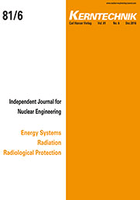
KERNTECHNIK
Scope & Guideline
Bridging research and industry for nuclear advancements.
Introduction
Aims and Scopes
- Nuclear Safety and Risk Assessment:
Research on methodologies for assessing safety and risks associated with nuclear power plants, including probabilistic safety assessments and reliability analysis of safety systems. - Reactor Design and Optimization:
Studies focusing on the design, optimization, and performance evaluation of various nuclear reactor types, including thermal-hydraulic modeling and neutronic simulations. - Radioactive Waste Management:
Research on the handling, treatment, and disposal of radioactive waste, emphasizing contamination analysis, waste storage security, and mitigation strategies. - Advanced Reactor Technologies:
Exploration of new reactor designs and technologies, including small modular reactors (SMRs), thorium reactors, and fusion reactors, aimed at improving sustainability and safety. - Computational Fluid Dynamics (CFD) Applications:
Utilization of CFD methods to analyze fluid dynamics and heat transfer in nuclear applications, enhancing the understanding of reactor behavior and safety. - Environmental Impact and Radiological Protection:
Investigation into the environmental implications of nuclear technology, including radiation protection measures and the assessment of radioactive discharges.
Trending and Emerging
- Artificial Intelligence and Machine Learning Applications:
There is a growing interest in utilizing AI and machine learning techniques for various applications, including safety assessments, predictive maintenance, and operational optimizations within nuclear systems. - Sustainable Nuclear Technologies:
Research focusing on sustainability aspects of nuclear energy, including the development of small modular reactors (SMRs) and advanced fuel cycles that aim to minimize waste and enhance efficiency. - Integrated Safety and Security Systems:
Emerging studies are increasingly addressing the intersection of safety and security in nuclear facilities, particularly in the context of cybersecurity and physical protection against threats. - Multiphase Flow and Heat Transfer Studies:
The analysis of multiphase flow and heat transfer phenomena in nuclear reactors is becoming a key area of research, particularly with the use of advanced materials and nanofluids. - Environmental and Health Impact Assessments:
There is a rising focus on assessing the environmental and health impacts of nuclear technologies, particularly in relation to radioactive waste management and emissions.
Declining or Waning
- Traditional Reactor Safety Protocols:
Research focusing on conventional safety protocols and designs appears to be declining, possibly due to the shift towards more advanced technologies and methodologies. - Basic Radiation Protection Concepts:
There seems to be a reduction in studies solely emphasizing foundational radiation protection principles, as the field advances towards integrated and technology-driven approaches. - Historical Reviews of Nuclear Energy:
There is a noticeable decrease in papers that provide historical perspectives on nuclear energy development, indicating a shift towards current and future-oriented research. - Nuclear Power Plant Decommissioning Strategies:
While still relevant, the frequency of publications focused exclusively on decommissioning strategies has diminished, perhaps due to a focus on operational and safety improvements in existing plants. - Conventional Fuel Cycle Analysis:
Research surrounding traditional fuel cycle analysis, particularly for light water reactors, has become less prominent compared to studies on alternative fuels and next-generation reactors.
Similar Journals

THERMAL ENGINEERING
Exploring Innovations in Thermal Processes and TechnologiesTHERMAL ENGINEERING is a premier journal dedicated to advancing the field of thermal engineering, with particular importance in the domains of Energy Engineering, Nuclear Energy, and Power Technology. Published by PLEIADES PUBLISHING INC, this esteemed journal has been providing significant scholarly contributions since its inception, with its converged years spanning from 1970 to 2024. Though currently non-open access, the journal presents a unique avenue for researchers, professionals, and students to explore groundbreaking research and innovative solutions related to energy systems and thermal processes. With a notable impact factor and positioned in the Q3 quartile for both Energy Engineering and Nuclear Energy, THERMAL ENGINEERING ensures the dissemination of high-quality research with a global reach, making it an essential resource for those looking to stay at the forefront of essential energy technologies and engineering advancements.

NUCLEAR ENGINEERING AND DESIGN
Elevating Standards in Nuclear Engineering ResearchNUCLEAR ENGINEERING AND DESIGN is a prestigious journal published by Elsevier Science SA, which has been contributing to the field of nuclear science since 1965. With ISSN 0029-5493 and E-ISSN 1872-759X, it serves as a vital platform for researchers, professionals, and students in areas including nuclear energy, safety, mechanical engineering, and waste management. This journal is highly regarded, reflected in its impressive Q1 status in categories such as Nuclear Energy and Engineering and Safety, Risk, Reliability and Quality, as well as its ranking within the top quartiles of other related fields according to the 2023 category quartiles. Though not an open-access journal, it provides comprehensive insights into cutting-edge research and innovative practices in nuclear engineering, making it an essential resource for advancing knowledge and applications in this critical sector. With a forward-looking scope extending to 2024, NUCLEAR ENGINEERING AND DESIGN continues to influence developments in nuclear technology and safety protocols worldwide.
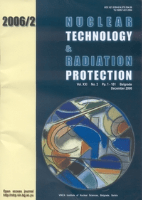
Nuclear Technology & Radiation Protection
Fostering collaboration in nuclear science and safety.Nuclear Technology & Radiation Protection is a distinguished open-access journal published by the VINCA Institute of Nuclear Sciences, Serbia, dedicated to advancing knowledge in the fields of nuclear energy and radiation safety. Since its inception in 2002, the journal has been an essential resource for researchers, professionals, and students, offering a platform for the dissemination of high-quality research that contributes to the safe and efficient use of nuclear technology. With an impressive Q2 ranking in both the Nuclear Energy and Engineering and Safety, Risk, Reliability and Quality categories for 2023, the journal reflects a commitment to excellence and relevance within its scope. It serves as a pivotal forum for sharing innovative findings, addressing current challenges, and contributing to the global discourse on nuclear safety and technology. The journal is indexed in Scopus, enhancing its visibility and impact in the academic community. By facilitating unrestricted access to its articles, Nuclear Technology & Radiation Protection continues to foster collaboration and engagement among scholars in the nuclear science domain.
Mechanical Engineering Journal
Pioneering research that shapes the future of engineering.The Mechanical Engineering Journal, published by the Japan Society of Mechanical Engineers, serves as a premier platform for scholarly discourse in the field of mechanical engineering. With an ISSN of 2187-9745 and embracing an Open Access model since 2014, this journal fosters wide dissemination of research findings, ensuring that valuable insights are accessible to a global audience. The journal aims to bridge the gap between theoretical advancements and practical applications in mechanical engineering, making it a vital resource for researchers, industry professionals, and students alike. Located in the heart of Tokyo, Japan, this publication upholds the highest standards of academic integrity and innovation, contributing significantly to advancements in mechanical engineering and related disciplines. Stay abreast of powerful research that pushes the boundaries of technology and engineering applications by exploring the latest issues of this influential journal.

Problems of Atomic Science and Technology
Pioneering Research in Atomic Phenomena.Problems of Atomic Science and Technology is a leading journal in the realm of nuclear physics and technology, published by the esteemed Kharkov Institute of Physics and Technology. With an ISSN of 1562-6016, this journal is dedicated to disseminating high-quality research and advancements in atomic sciences, contributing significantly to both academic and practical applications in the field. Although not an open access publication, it ensures rigorous peer review standards to maintain the integrity and relevance of cited works. The journal seeks to provide a vital platform for researchers, professionals, and students who are engaged in the exploration of atomic phenomena, nuclear engineering, and associated technologies. Published from Kharkov, Ukraine, the journal also serves as a bridge for international collaboration and innovation, making it indispensable for anyone looking to stay at the forefront of atomic science research.
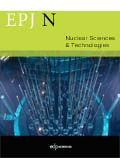
EPJ Nuclear Sciences & Technologies
Advancing the Frontiers of Nuclear InnovationEPJ Nuclear Sciences & Technologies is a prominent Open Access journal published by EDP Sciences S A, focusing on the vital fields of Nuclear and High Energy Physics, Nuclear Energy and Engineering, and Energy Engineering and Power Technology. Launched in 2015, this journal provides a platform for researchers, students, and professionals to disseminate cutting-edge research and innovations that address the challenges and opportunities in nuclear sciences, a field of critical importance in today’s energy landscape. With an ISSN of 2491-9292 and an evolving impact reflected in its 2023 Q3 quartile rankings across several relevant categories, EPJ Nuclear Sciences & Technologies is committed to promoting high-quality, peer-reviewed research accessible to a global audience. Its dedicated focus on enhancing knowledge transfer and international collaboration makes it an essential resource for anyone engaged in nuclear sciences and technologies.

Nuclear Physics and Atomic Energy
Bridging gaps in nuclear and high-energy physics.Nuclear Physics and Atomic Energy is a reputable open-access journal that focuses on the fields of nuclear physics and high-energy physics, providing a forum for researchers, professionals, and students to share their findings and advancements. Published by the Institute of Nuclear Research, National Academy of Sciences of Ukraine, this journal has been committed to disseminating knowledge since its inception in 2006, ensuring that scientific advancements remain accessible to a global audience. With an ISSN of 1818-331X and an E-ISSN of 2074-0565, the journal features a diverse array of articles that span the continued exploration and application of nuclear phenomena. Although currently categorized in the Q4 quartile for Nuclear and High Energy Physics in 2023, the journal is steadily working towards increasing its impact and engagement within the academic community. With a Scopus rank of #74 out of 87 in its category, it serves as a valuable resource for advancing crucial research in a vital scientific area. Researchers are encouraged to contribute their innovative studies to foster collaboration and knowledge sharing in this dynamic field.
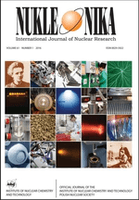
NUKLEONIKA
Connecting Ideas, Inspiring DiscoveriesNUKLEONIKA, published by SCIENDO, is a leading open access journal that has been serving the scientific community since its establishment in 1968. Focused on the domains of Nuclear and High Energy Physics, Condensed Matter Physics, and Nuclear Energy and Engineering, this journal provides a platform for innovative research and technological advancements in a variety of interdisciplinary fields. With an impressive history of publications and a current Q3 ranking in several categories, including Safety, Risk, Reliability and Quality and Waste Management and Disposal, NUKLEONIKA is recognized for its significant contributions to scientific discourse. Open access since 2014, the journal ensures that all research outputs are freely available, facilitating broad dissemination and accessibility for researchers, professionals, and students alike. Located in the heart of Warsaw, Poland, NUKLEONIKA aims to inspire collaborative efforts and foster a deeper understanding of complex physical phenomena and their practical implications.
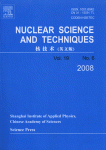
Nuclear Science and Techniques
Fostering Collaboration in the Nuclear CommunityNuclear Science and Techniques is a distinguished peer-reviewed journal published by Springer Singapore Pte Ltd, dedicated to advancing the fields of nuclear science and engineering. With an impressive impact factor reflected in its 2023 quartile rankings—Q2 in Nuclear and High Energy Physics and Q1 in Nuclear Energy and Engineering—the journal serves as a vital resource for researchers, professionals, and students alike. Covering a breadth of topics from nuclear physics to energy applications, it offers a platform for innovative research and developments in the nuclear domain. The journal, indexed under ISSN 1001-8042 and E-ISSN 2210-3147, aims to foster scientific exchange and collaboration within the community by publishing high-quality articles that contribute significantly to the field. Committed to maintaining an open-access ethos, it enhances visibility and accessibility of critical knowledge, making it an essential source for current insights and trends in nuclear science.
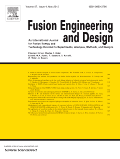
FUSION ENGINEERING AND DESIGN
Pioneering Research in Fusion and Materials Science.FUSION ENGINEERING AND DESIGN is a premier scientific journal published by Elsevier Science SA, dedicated to advancing the field of fusion engineering, materials science, and related disciplines. Established in 1985 and running through 2024, this journal features cutting-edge research that spans multiple categories, including Civil and Structural Engineering, Mechanical Engineering, Materials Science, and Nuclear Energy and Engineering, holding a notable Q2 quartile ranking in each field as of 2023. Catering to a global audience of researchers and professionals, FUSION ENGINEERING AND DESIGN emphasizes the importance of interdisciplinary collaboration and innovative technology in tackling the complex challenges associated with fusion energy. Although it does not offer Open Access, the journal remains an essential resource for those seeking to stay abreast of developments that could shape the future of energy solutions and engineering methodologies. With a dedicated editorial board and a commitment to high-impact publication, this journal serves as a vital platform for disseminating transformative ideas and driving forward the scientific dialogue in fusion engineering.